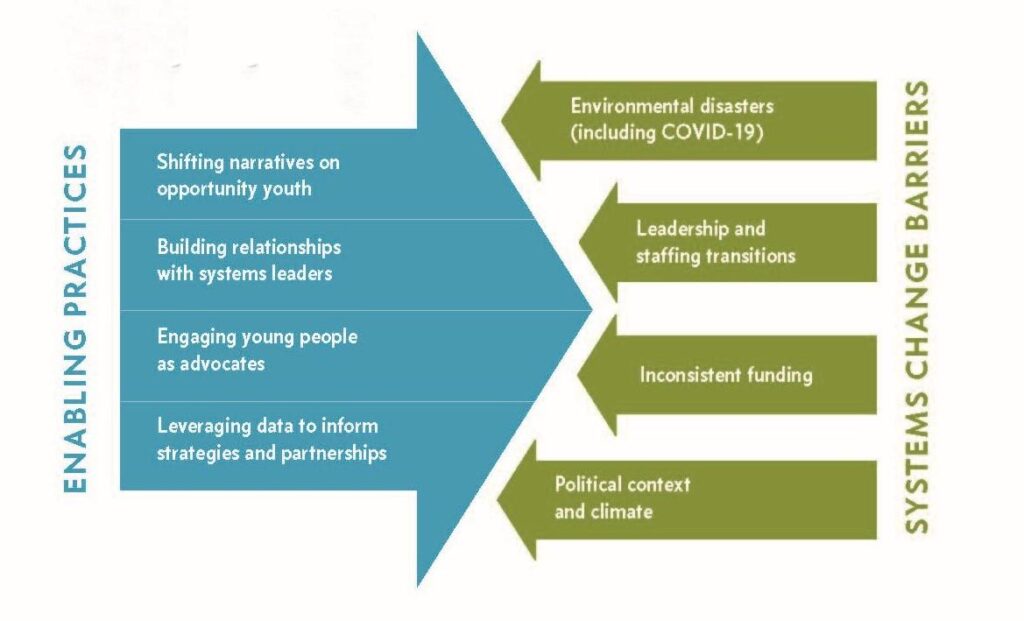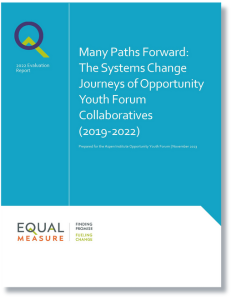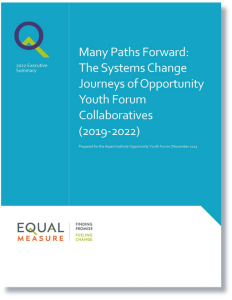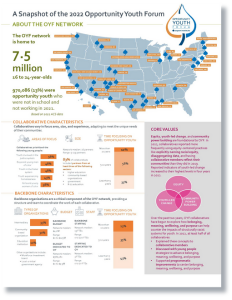Building on a decade as learning and evaluation partner for the Aspen Institute Forum for Community Solutions’ Opportunity Youth Forum, Equal Measure’s latest report looks at how systems change is emerging over time among collaboratives in an expanding network engaged in improving lives and outcomes for young people between the ages of 16 and 24 who are disconnected from school and work. The report illuminates trends in community-led systems change from data collected across a four-year period (2019–2022).
In addition to a 2022 snapshot, in this report we sought to understand the arc of systems change work. What are the trends over time? And what can we infer from those trends about how community-led systems change occurs?
The theme that emerged from our data underscored the indirect and nonlinear nature of systems change. Over time, and across the nation, progress occurred in fits and starts, and OYF collectives took many different journeys towards sustaining and enhancing change to the systems that impact Opportunity Youth.
Through interviews conducted with OYF site leaders, Equal Measure categorized a set of strategies collaboratives have used to help maintain momentum on their systems change pursuits, “weathering the storm” through the conditions and contexts that can impede progress. This diagram summarizes the factors that speed, and slow, systems change progress:

Five Systems Change Journeys
The Opportunity Youth Forum (OYF) network has grown significantly over the last four years, from 27 collaboratives in 2019 to 43 collaboratives in 2022—a 59% increase. As the national network has expanded, its characteristics, the communities served, and the backbone organizations that coordinate systems change efforts for opportunity youth have also shifted.
Trends at the network level tell the broad story of systems change for a diverse and ever-changing group of opportunity youth collaboratives over time. Looking at how individual collaboratives begin to shift systems over several years provides a more nuanced story of the different types of paths collaboratives may take to changing systems to improve outcomes for opportunity youth. Equal Measure found two important themes:
There is no one common journey toward systems change for collaboratives in the OYF network.
Among collaboratives with at least three years of self-assessment data, more than half (56%) improved systems change from 2019 to 2022. However, the year-to-year journeys were varied, with the majority of collaboratives experiencing one of these five paths:
- Steady growth: A more linear progression in the work and community impact
- Zigzag: Yearly changes from 2019 to 2022
- U-shape: Declines followed by rebounds or a period of growth
- Growth, then decline: Growth over three years and then a decline in 2022, likely due to significant internal staff transitions and funding challenges
- Steady declines: Only 8% of collaboratives (2 collaboratives) had steady declines in systems change over three to four years.
Systems change work is not a direct and linear process.
The variety of journeys suggests that many factors can influence a collaborative and a community’s ability to shift their local systems in the short term. Furthermore, collaboratives may intentionally pause their systems change work to prioritize the immediate needs of the community, such as during the COVID-19 pandemic or other emergencies such as climate disasters.
What Helps Accelerate Systems Change Among OYF Collaboratives?
Despite the potential for roadblocks, many OYF collaboratives maintained and improved systems change progress over the years. Through interviews conducted with OYF site leaders, Equal Measure categorized a set of strategies collaboratives have used to help maintain momentum on their systems change pursuits, “weathering the storm” through the conditions and contexts that can impede progress.
These strategies include:
- Shifting public narratives and dispositions on opportunity youth to sustain systems change
- Building relationships to maintain momentum
- Engaging young people as systems change advocates
- Leveraging data to jumpstart systems change
DOWNLOAD THE RESOURCES
PROJECT TEAM MEMBERS:
- Jennifer Thompson
- Dan Tsin
- Kristin Giordano
- Roseleni Ortiz Ramos
- Giselle Saleet
- Carise Mitch
- Robert Roach


